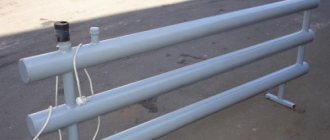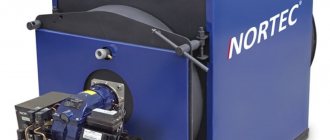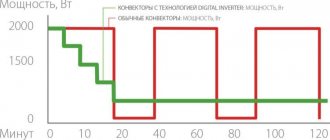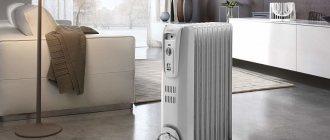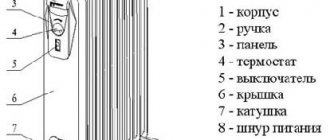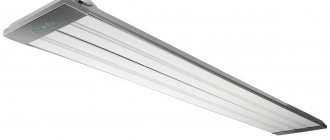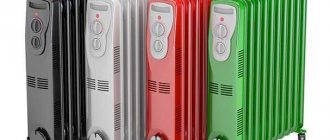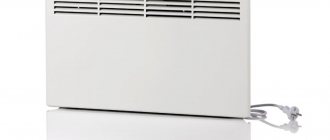Infrared heaters appeared relatively recently, but have already gained popularity. The main advantage of such devices is directed heating, i.e. heat does not dissipate in the air, but warms up the selected area or object. A carbon heater differs from its counterparts only in the heating element, which is made from carbon fiber. This material is durable and economical, but significantly increases the price of the device compared to other infrared models.
Internal structure and advantages over other units
This device is in many ways similar to conventional IR heaters, but instead of a tungsten spiral, carbon fiber in the form of twisted ribbons and cords, placed in a quartz tube from which air is displaced, is used as a heating element.
The electric current passing through this fiber heats the carbon filament, which produces infrared radiation. IR rays, reaching surfaces and objects, heat them to a depth of about 2 cm, after which the objects give off heat to the surrounding space.
Carbon heaters have a modern design. You can always choose the right option for any room style
An undeniable advantage over fan heaters and oil heaters is that with low power consumption, these devices have high thermal performance. So, if an oil heater with a power of 1 kW is enough to warm up 10 square meters. m of area, then a carbon fiber one with the same power will provide heat to 30 sq. m. m., and will continue to maintain the required temperature.
Worth paying attention! Thanks to the properties of carbon fiber, heaters of this type compare favorably with traditional devices. Their energy consumption is 2-2.5 times lower with the same efficiency.
In addition to rational energy consumption, infrared carbon heaters have an aesthetically attractive appearance, compact size and modern design. The temperature of the heating element cannot exceed 90 °C. Consequently, there is no negative impact on the ecology and microclimate of the room: the heater does not dry the air and does not burn oxygen.
The performance characteristics inherent in heaters of this type are quite attractive to the consumer. These include:
- economical energy consumption;
- practically unlimited service life of the heating element, which is protected from moisture and dust;
- compact dimensions and weight within 4 kilograms;
- mobility;
- quite powerful heat flow;
- instant targeted heating and very fast cooling when switched off;
- Possibility of outdoor use (balcony, greenhouse);
fire safety.
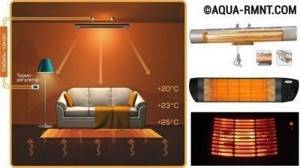
Wall-mounted carbon heaters are good because they take up virtually no space, do not interfere, and are capable of covering and warming a significant area with useful radiation
An interesting feature is the ability of these devices to have a beneficial effect on the human body.
Infrared rays emanating from the heater can penetrate deep into the body, which significantly improves blood circulation and serves as a prevention of colds and inflammatory processes in joints and muscles.
Carbon lamp structure
This emitter lamp is a quartz glass tube sealed at the ends, into which an incandescent filament made of a special carbon fiber - carbon - is placed under vacuum conditions.

Carbon was chosen as a filament for a reason - an infrared emitter of this design operates in the long-wave range, eliminating the factor of undesirable long-term exposure to short-wave radiation on humans. In addition, the service life of carbon lamps is on average 100 thousand hours, which in terms of months of the heating season is approximately 10 calendar years.
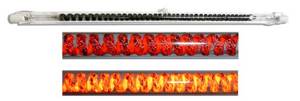
The long service life is due to the fact that the coefficient of linear thermal expansion of carbon fiber, in contrast to tungsten or nichrome, is close to zero, and carbon fiber by definition does not have a factor of metal fatigue from thermal deformation when turning the device on and off.
Best models
An infrared carbon heater is quite simple to choose. Now there are many models. Here are the best:
- Zenet SMB-60E. This is a device created in Germany. Power is 600 W. Heats an area approximately equal to 15 m². This option is floor-mounted. Approximate cost: 3,500 rubles.
- Zenet NSKT-90С. Floor option. Power 1200 W. The device heats a space of 30 m². The cost is about 4,000 rubles.
- Veito heaters. Turkish production. This is a great option for an apartment. The device has a pleasant appearance. The assembly is very high quality.
- UFO-3000. Also made in Turkey. Power is 3,000 W. Can heat a room of 40 m². A long-term warranty is provided - 3 years. But the cost of such a device is quite high - approximately 9,000 rubles.
- UFO-3000 UK. The carbon heater has the same parameters as the previous version, but the warranty period is only 1 year. The cost is about 10,000 rubles.
- AIC NS-800B is manufactured in Italy. Considered to be of very high quality. The power is 800 W, so it is suitable for heating a small space of no more than 25 m². A one-year warranty is provided. The price is approximately 3,300 rubles.
- Maximus Light 2 400. This is a Chinese-made device. Power is 2,500 W. The device weighs only 3 kg. Can heat a room of 23 m² Cost 3,700 rubles.
- Noirot Royat 2 1800-K. The device is created in France. Weighs only 2 kg. The power is small - only 1,800 W, heats an area of 20 m². The cost is just over 5,000 rubles. A 6-year warranty is provided.
- Sinbo SFH 2209. This is another IR heater that is created in Turkey. The power is 1000 W, so the maximum area that can be heated is only 20 m². It weighs no more than 1.8 kg. The cost is almost 3,000 rubles.
- AEG IWQ-120. Inexpensive wall-mounted carbon heater made in Germany. It is suitable for rooms larger than 12 m². You can adjust the power and energy consumption. The device has a housing made of moisture-proof material. The radiation angle can be changed. This device can be used not only indoors, but also outdoors. The only drawback is that there is no thermostat.
- Polaris PKSH-0508H. These panels are perfect for rooms with an area of more than 20 m². This option is floor-mounted. It can be positioned both vertically and horizontally. There is a timer up to 3 hours. Another advantage is the beautiful design. But there are also disadvantages, including low power. There is no thermostat and moisture protection. The model is not stable.
- Neoclima NC-CH-3000. This device has a fairly large area, but the price is also not small. But it can warm even a large room in a few minutes. There are 3 operating modes, so energy losses can be reduced, but the equipment will still operate efficiently. There is no timer or thermostat. This model is more suitable for garages, offices, showrooms. But there are also disadvantages - a rough design, short wire length and high electrical energy consumption.
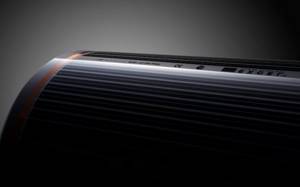
Advantages and disadvantages
Advantages of innovative models:
- the use of equipment that produces infrared radiation for daily heating has a positive effect on the body - it helps to increase the intensity of blood circulation, stimulates the natural rhythm of the gastrointestinal tract, and in the winter months it replenishes the lack of sun;
- Zenet carbon heaters and their analogues in the price range are highly environmentally friendly, they do not dry out the air, do not emit odors or harmful substances, and do not burn oxygen;
- The devices attract with their modern design and fit perfectly into any interior;
- devices consume electricity economically - carbon fiber exhibits high heat transfer, equipment with low power can quickly warm up a room;
- Possibility of use as outdoor heaters;
- high degree of protection against contact with moisture.
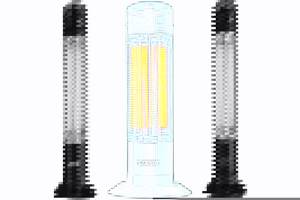
Carbon heaters do not dry out the air and do not emit odors.
Potential buyers who are faced with such a solution for the first time are wondering about the possible harm of an infrared heater. Experts note that here radiation is not only clearly safe, but also beneficial. The carbon does not evaporate - it is placed in a vacuum in a tightly pressed tube.
But the disadvantages cannot be ignored:
- the design is very fragile, you should be careful about falling of the glass container - it can easily burst;
- during operation, the unit makes characteristic sounds;
- high cost, noticeable compared to the price tags for traditional mobile heating devices.
Moreover, the device does not create loud noises, but when it cools for a short time, a crackling sound can be heard.
Advantages and disadvantages
The carbon heater, as the youngest, is the most advanced unit among lamp heating devices, which also determines its higher technical characteristics. Let's list the pros and cons of these devices, both inherent in all infrared heaters and characteristic only of carbon units.
- High efficiency – close to 95%.
- Economical:
- low level of energy consumption - due to the high thermal conductivity of carbon, which allows it to consume almost half as much electricity to generate a unit of heat as most traditional types of electric heaters;
- the long service life of the unit is also ensured by the unique properties of the carbon fiber.
- Lack of short-wave radiation - long-wave radiation from carbon does not have a harmful effect on humans and does not change the characteristics of the air in the room (humidity, oxygen content).
- High degree of safety of use.
- Wide range of design and construction options.
- Compact and light weight (2-4 kg).
- Optimal level of automation of the heater operation (thermostat, tilt sensor, remote control).
- Easy to use and daily care.
- Quiet operation.
- Affordable price.
The list of advantages of a carbon heater is impressive, but there are also disadvantages:
- low efficiency of directional heating in the fresh air - due to the characteristics of long-wave radiation;
- high probability of destruction of quartz tubes of carbon lamps if the device is accidentally dropped;
- the inability of long-wave radiation to bend around obstacles - an object that is in the path of the rays will be heated.
The listed disadvantages are not critical, and rather serve an informative function rather than determine the choice of device when purchasing.
Types of carbon heaters for home
Depending on the design, there are wall-mounted, floor-mounted, ceiling-mounted and rotary models.
Characteristics of wall-mounted devices
The main advantage of wall-mounted models of carbon heaters is saving living space. Due to the fact that the heater has special mounts for mounting on the wall, it can be placed even in a small apartment without harm to the residents.
After all, when every centimeter of the room is important, then a wall-mounted structure will be the most reasonable option for a heating device.
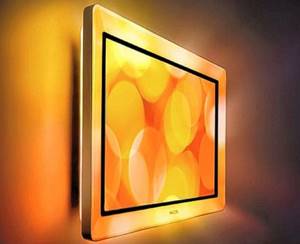
A wall-mounted infrared heater can not only heat apartment residents, but also fit unnoticed into the interior. By choosing the most successful model of the device, you can thus add a unique twist to the design of the room.
There are no special features in the design of the wall heater. You can install it yourself, without resorting to the services of specialists. The fastenings provided by the manufacturer are reliable. They are able to support a device that has such a small weight - up to 4 kg.
The cost of a wall-mounted model largely depends on the popularity of the manufacturer and its reputation in the market.
Also, the price is directly affected by the power of the device, the warranty period of service, additional functions and capabilities provided by the device developers.
To properly install a wall heater, you need to determine what items should be in its working area. It is advisable to mount the device so that it has a maximum viewing angle.
If you choose a bad place, you will have to re-weight it. For such models, it is important that the control panel is included.
The main disadvantage of wall-mounted carbon devices is the difficulty of maintenance - in order to wipe off the dust, you still need to get to it. The second is the higher cost compared to floor options.
This is due to the presence of mandatory functions for adjusting the temperature and operating power of the device via the control panel.

An infrared device placed high above your head will keep you at a safe distance from small children. Of course, you will have to make an effort to wipe the dust off it.
On the other hand, the installation location, located above the head, is considered by some consumers to be one of the advantages. Wall and ceiling models are in great demand among families with children. It is convenient that the device is out of reach of a child.
Ceiling carbon devices
Carbon heaters can be installed on the ceiling. Manufacturers offer various models that can be safely integrated into any interior without damaging it. There are options mounted into a suspended ceiling structure.
Before installing ceiling carbon heaters, it is important to correctly calculate the required power and select their installation locations. Such options are most often used for heating industrial premises with high ceilings. High-power models that have more than one heating element are suitable here.
Small devices of 800-2500 W are installed as additional heating equipment in country houses. This is very convenient - literally 10 seconds after turning it on, it starts working, warming chilled guests and the pieces of furniture on which they settled.

Ceiling models are easy to install and look decent. They can be used not only for home use, but also for heating visitors to cafes and restaurants.
When using ceiling heaters, do not place objects, devices with plastic casings, or fabrics too close. Excessive heating of the plastic may cause an unpleasant odor.
A ceiling device equipped with a timer and thermostat is capable of maintaining a comfortable temperature setting once set by the user. Also, there are models that can remember several temperature options.
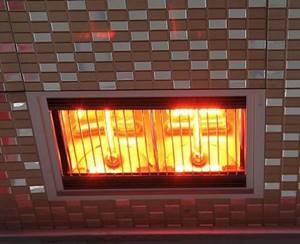
The carbon fiber ceiling heater can be installed directly into the suspended ceiling structure. It all depends on the model. There are options that completely match the color of the ceiling material
Carbon appliances do not dry out the air, because the heating element is not in direct contact with the air. Therefore, in rooms with such heaters you will not have to worry about additional humidification.
Features of floor heaters
The most common models of carbon heaters are floor-standing. They come in a variety of sizes and shapes - it all depends on the designer’s imagination. Their main advantage is mobility and light weight. Such a device can be loaded into a car and taken with you to the dacha.
Based on their appearance, floor heaters are divided into horizontal and vertical. Depending on their capabilities, there are stationary and rotary devices. The angle of rotation depends on individual characteristics - from 90° to 180°.
This feature appealed to a large number of buyers. Also, models with remote control are in particular demand, despite their higher cost.

Floor-standing designs of carbon heaters are distinguished by the ability to rotate the working surface in the desired direction without moving the device itself. The function is provided due to the presence of rotating mechanisms
The ease of use of floor-standing appliances speaks for itself - you install it and you can turn it on. No installation required. The variety of shapes allows you to choose the best option for your home, harmoniously combined with the interior.
The carbon heater creates a special cozy atmosphere in the room, as if a fireplace was used for heating.
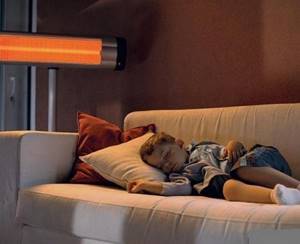
Floor-standing devices should be placed strictly on horizontal surfaces. Moreover, the heater must be on a hard surface in a horizontal position to avoid accidental falls.
For safety reasons, floor-type carbon heaters are equipped with an automatic shut-off function. It is triggered when it heats up above the permissible temperature or when the device overturns. If the owner accidentally drops a working heater, an automatic relay will turn off the device.
To maintain a comfortable temperature without human intervention, you can use a thermostat for the outlet when connecting the heater.
Flat or film type systems
One of the varieties of carbon heaters can be called film-type devices that operate on the basis of carbon fibers laid parallel to each other. You can install such films yourself.
To do this, you will need to carefully calculate the required heating area, carefully cut the film without damaging the strips with the heating element.
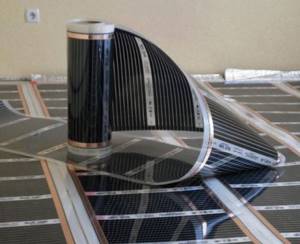
When installing a film heater yourself, you need to carefully measure the area for its installation, then carefully cut the required size of the film, being careful not to damage the heating strips. Otherwise, the damaged piece will have to be replaced with a whole one.
When installing infrared film, it is important that the sections do not overlap each other. Furniture cannot be placed in their locations. This insulation system copes well with the function of heating a loggia or a separate area of the room.
The efficiency of the devices is quite high - because the generated heat is not wasted, it is directed to objects.
Carbon heating films can be installed on the ceiling, wall or floor. Manufacturers offer improved versions of film-type devices, designed in the form of paintings. Decorative finishing is applied to the plasterboard frame. The main condition is that this design should not contain metal parts.
Job: benefits
Structurally, a carbon heater is formed by a glass, ceramic tube filled with carbon fiber. The carbon filament has a high efficiency; the electricity conducted by the carbon becomes heat without wasting resources on visible heat. Accordingly, using carbon electric heaters, we achieve energy savings.
With an increase in the efficiency of heating rooms, we get tangible savings; even a small living space, heating rationally, will save the family budget. Office and industrial premises, especially those with high traffic in the cold season, if properly heated, will save most of the operating costs.
The efficiency of heaters is supported by the following factor - the absence of metal stretching when heated. The carbon filament is unchanged, has a constant geometric size when heated, and there is no “fatigue” of the metal. Breakage is not possible due to sudden temperature changes. Associated with long-term performance without the need to replace the heater. The average service life of a carbon heater is 100,000 hours (much longer than LED bulbs).
The industry produces carbon heaters of any power: tens of watts of local heating, multi-kilowatt, designed to provide heat to production premises, used in drying chambers.
Infrared radiation is maximally absorbed by the material, and thermal energy is no longer wasted on useless heating of the air space. A distinctive feature and advantage of carbon heaters is indicated.
Heat is transferred to the object, directly bypassing the intermediary - the atmosphere. Classic heaters, heating a space, transfer energy to an object through air.
An important feature of heat distribution is spot heating; by directing the working area of the heater, we heat only a selected item. The movement of air flows in the room will not have any effect on the degree or intensity of heating. Classic heaters spend the lion's share of energy delivering heat to the destination.
The absence of open thermal heating elements eliminates drying and combustion of oxygen in the atmosphere. For example, spiral, nichrome heaters burn out 80% of the oxygen in the room, which is especially important today, with the widespread installation of sealed metal-plastic windows that disrupt the natural circulation of the atmosphere. The humidity of the room where the carbon heater is used does not change, and the internal microclimate remains comfortable.
The structure of the carbon thread is characterized by a loose structure, fibrous, with many radiating micro surfaces, accelerated entry into operating mode is achieved, to the temperature declared by the manufacturer, the carbon heater warms up in 10 -15 seconds. Possessing low inertia and thermal conductivity, the heater instantly cools when the power is turned off.
How to choose a carbon heater
When purchasing, remember that a carbon heater is only suitable for additional or temporary heating. It is necessary to determine the location of its installation and the required power. There are rotating and non-rotating models. A device with the ability to rotate, as a rule, implies floor installation. Wall-mounted carbon heaters have a limited angle for more precise focusing, and ceiling panels usually lack this feature.
In addition to the power of the device and the method of its installation, you should pay attention to the range of IR radiation. Carbon heating elements differ in the range of emitted waves:
- Short-wave with wavelength up to 25 microns. The element can be heated up to 400 °C. For safety reasons, installation on a ceiling with a height of 3 m or more is recommended. Usually used in non-residential premises (warehouses, production workshops).
- The average wavelength is 50-100 microns. Suitable for any room and type of installation. Recommended for temporary or additional heating. Able to penetrate shallowly into the skin.
- Long-wavelength (200-340 microns) are most comfortable for humans. The fiber is heated to 50 °C. Most carbon heaters have this wavelength.
The heating area depends on the power of the device. 1000 Watt models can heat only 10 square meters. m., and in the open air this figure drops to 6 square meters. m. For the effective operation of a carbon heater, the integrity of the vacuum tube is important. While the quality of workmanship and assembly can still be determined by eye, the condition of a quartz vessel is almost impossible to check. A reliable sales network and the availability of the necessary certificates can serve as a guarantee.
Carbon heating element design
The consumer’s desire to buy a heating device that does not dry out the air, warms well, and uses a minimum amount of energy is feasible. A carbon heater, which is one of the types of infrared devices, can fulfill these requirements. It is based on a carbon heating element.
Carbon is the carbon from which the filaments that serve as the basis of the heater are made. They are twisted into a spiral placed in a vacuum tube made of tempered glass. The thickness of the spiral depends on the power of the device - the higher the power, the denser and longer the carbon thread will be.
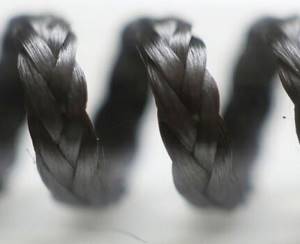
Carbon fiber threads are the basis of a carbon heater. They are tightly intertwined with each other, forming a kind of ribbon twisted into a spiral.
This type of heater is capable of producing infrared rays of 1800-2400 nanometers, while having a negative temperature coefficient. This means that as the temperature increases, it will need less electricity.

The carbon fibers that make up the heater spiral have different lengths. The thickness of the spiral and the frequency of repetition of sections depends on the expected power of the device
A carbon fiber spiral enclosed in a vacuum tube does not burn out when heated. This is a significant advantage over tungsten heating elements.
This feature allows you to use the heater for a long time, adhering to the rules of operation of a device containing a carbon filament.
Criterias of choice
Owners can use a carbon heater for both primary and additional heating of rooms. It all depends on the area that requires heating; the temperature depends on the comfort for the owners. If the room is small, a long-wave model will be sufficient. For spacious rooms you will need a medium wave or short wave device.
A ceiling heater is recommended for those who like to walk barefoot on the floor. It will always be warm, since the radiation rushes vertically down. Small models can look beautiful in a suspended ceiling design, giving it an original look.
For those who want to minimize the space occupied by the device, a wall-mounted model is suitable. It would be appropriate opposite the following furniture:
- bed or sofa;
- armchairs where they like to spend time reading books or watching TV;
- table where children do their homework.
And in order to be able to regulate the direction of radiation, it is worth paying attention to devices that can rotate at a certain angle.
Those who want to use their heater not in one room, but in several, need to opt for mobile floor models. They are compact, weigh a little, and owners can easily leave them near the bed of a child or sick person to quickly warm them with pleasant warmth. The main thing to remember is that they need to be placed at a safe distance.
Read more: Health and beauty of pets: TOP-18 best food for sterilized cats
Shortwave units are universal. They are installed everywhere - in city apartments, country houses, offices, industrial facilities. They create the most powerful heat flow and can quickly raise the temperature in a frozen room. With their help, heating is carried out on the street, placed on the territory of a personal plot or cottage, on areas in front of establishments.
The first significant factor is the location of the future installation of the unit. If you do not plan to permanently locate the device and want the ability to move the device according to your needs, it is better to opt for a portable modification - a floor-mounted one with legs or a tripod.
Models in which the heating elements are located vertically have compact dimensions; they are purchased mainly for small rooms; in this case, the power will not exceed 2 kW, which is enough to maintain a comfortable microclimate in a room of up to 20 square meters. m.

Carbon heater with vertical heating elements
If you are concerned about the safety of children and pets, ceiling and wall variations will be more justified. The additional option of rotating the reflector is welcome. In this situation, you need to pay special attention to the reliability of the structure and the strength of the brackets. The power cable must be equipped with a grounding conductor connected to the device body, and a protective metal grill must be installed on the carbon lamp.

The optimal reflector material is compacted foil (to check its strength, lightly press it with your finger; the surface should offer resistance). The main requirement for the heater body is the presence of a high-quality paint layer without scratches or chips; it will protect the device from the development of corrosion.
Carbon heater is one of the safe devices capable of long service life. Of course, if used correctly.
It does not burn oxygen, does not reduce the level of humidity in the room, is safe for children, and does not emit any harmful gases, vapors, or toxic substances.
Image gallery
Photo from
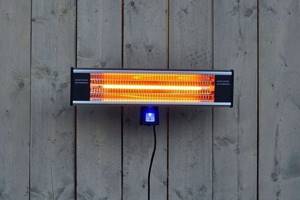
When selecting a heating device, not the last place should be given to additional options, for example, an overheating protection system
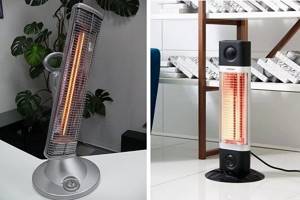
An important argument when choosing a portable outdoor device is the tip-over sensor, which turns off the device in risky cases.
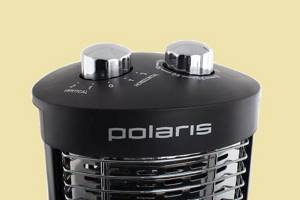
For many users, very important additions are a timer and a knob that allows you to select the mode and power of the device.
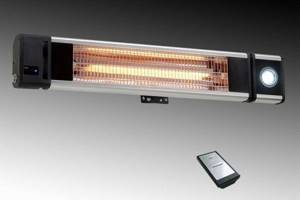
In the configuration of wall and ceiling options, the presence of a remote control is considered important
Options - guidelines for choosing an infrared heater
Protective systems for floor heaters
Functions for adjusting period and operating mode
Control panel for ceiling and wall systems
The safety of carbon heaters has been proven by their successful use since the beginning of 2000. More than 15 years of practical use of devices with a carbon heating element prove that they do not cause harm to health. More information about myths regarding infrared emitters is written in this article.

For home use, many consumers prefer to buy a floor-standing heater model. Also, they choose to have the functions of turning, power adjustment, automatic shutdown, and rollover protection.
In order for the use of carbon heaters to bring only positive emotions, you need to choose the right model that is suitable for a specific consumer.
When choosing, it is important to consider a number of features:
- where the device will be used - in a country house, in an apartment, office or other type of premises;
- the area to be heated;
- what type of device is most suitable in a particular situation;
- required power;
- availability of additional functions and capabilities;
- the size of the budget allocated for the purchase.
For buyers who value the fame and reputation of the equipment manufacturer, the cost will be slightly higher - they will have to pay extra for the brand.

For office premises, ceiling and wall models are chosen. This design allows you to create an optimal temperature background for good staff performance
Among manufacturers of carbon heaters, the following devices are most popular:
- German Zenet models;
- French Noirot Royat;
- Turkish UFO, Maximus, Sinbo;
- Chinese Polaris;
- Russian BiLux.
The power of the devices, their design and heated area depend on the model and manufacturer. Also, the warranty period for heaters ranges from 12 months to 6 years. It all depends on the manufacturer.
Devices of different brands with the same power can cope with heating of different areas. This fact should be taken into account when choosing a suitable model, and carefully study the accompanying documentation of the model you like.
As for price, traditionally the cheapest options are offered by Chinese companies. There are many of them and most of them are not of high quality. Therefore, buyers prefer to purchase devices from well-known manufacturers.
One of the reliable brands of heaters produced in the Middle Kingdom are Polaris devices. They are trusted among buyers.

The heater should be placed at a distance of 1 m from furniture. If there is not enough space in the room to properly install the heater, then it is better to choose a model with wall or ceiling mounting
Which company to choose is a personal matter for each buyer. The main thing is that the heater meets all the requirements for it.
The most popular models are those controlled by remote control, equipped with a rotating mechanism and a timer. Users prefer comfort, even if they have to pay a little extra for it.
Interestingly, many buyers of carbon heaters talk about the beneficial effects of infrared rays generated during operation. This concerns improving blood circulation, easing the occurrence of colds and joint diseases. It is important to use the heater correctly so as not to harm yourself.
If you have not yet decided on the choice of a home heater, then read the article - Which heater is better to choose for a house and apartment: a comparative review of units
Appliance power and heated area
Often these concepts are interrelated, and the heated area directly depends on the power. On average, every 50 W of an infrared heating device can heat 1 m2 of room. That is, to choose a model suitable for your area, you need to use the following formula:
W = S*0.05, where S is the area of the room, 0.05 is the number of W required to warm up 1 m2.
For example, if you need to heat a room with an area of 25 m2, then you need a device with the following power:
W = 25 * 0.05 = 1.25 kW
The models themselves usually indicate the power and heated area, so we simply choose the appropriate one. However, remember that this is a fairly average formula, and some models may have a better or worse power/heated area ratio.
Is it possible to build such a heater yourself?
A homemade device operating on the principle of a carbon film can be built on your own from scrap materials. When performing such work, it is important to thoroughly dry all workpieces, check the power so that it can be safely connected to the network and pay special attention to insulation.
According to the craftsmen, a heater assembled with their own hands is not inferior in performance to purchased analogues.
To make it you will need:
- epoxy adhesive;
- copper terminals;
- wire with plug for connecting to the network;
- graphite powder;
- 2 sheets of laminated paper.
To obtain a graphite conductor, you need to mix epoxy glue with graphite powder. Stir the mixture thoroughly - it will serve as a heating element.
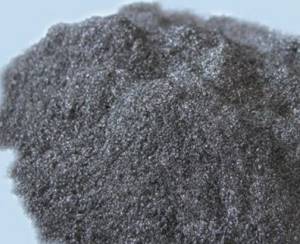
You can crumble graphite powder yourself by finding suitable waste material for this.
The resulting conductor must be applied in a zigzag pattern to the prepared sheet. Then you need to glue the sheets of plastic together with glue, attaching copper terminals to the conductor on different sides.
You can also connect a thermostat, which will help regulate the temperature after the heater is assembled.

The device, assembled by yourself, is easy to use. Its assembly does not require any special parts that are impossible to obtain. It is important to isolate everything well and be sure to test the capabilities of the created homemade product
Having carefully fastened everything, you have to leave the workpiece to dry completely. All contacts, wires and parts carrying current should be properly insulated. After drying, be sure to measure the resistance of the device and calculate its power. Without these tests, it is strictly forbidden to connect the device to the network.
Types of carbon heating devices
Carbon heating devices are manufactured portable (floor-mounted, tripod-mounted) or designed for installation on a wall or ceiling. These types of construction differ from each other only in the way they are positioned and attached to the base.
There is also a classification based on the orientation of the heating elements in the housing:
- horizontal;
- vertical.
Of these two designs, select the one that corresponds to the most rational placement of the device at the site of operation.
Models of carbon heaters also differ in the number of heating elements. Naturally, the more of them, the more efficient the device will be, but the more significant is the electricity consumption

By power, carbon heating devices are divided into household ones - from several tens of watts to 2-3 kilowatts and industrial, multi-kilowatt, used for heating industrial premises or ensuring the temperature regime in drying chambers.
How to make a carbon heater with your own hands
Devices with infrared radiation can be made independently, but carbon fiber cannot be created “on the knee”. The only way out is to use ready-made film. To work you will need:
- sheet of carbon film;
- reflector (ordinary metal foil will do);
- wires;
- thermostat.
You can take several sheets of film, place them on the wall or ceiling and connect them in parallel to the power supply. When installed on a ceiling, the height of the latter must be at least 2.5 m. Wooden and metal components are spaced 50 cm from the film, and the wire is laid 2-3 cm from the edge of the heating element. When connecting the circuit, you must contact a specialist so as not to overload the system and cause a short circuit.
Advice! To create a simple infrared heater, just place a sheet of foil on the wall behind the central heating radiator.
Operating principle
The heater is actually a high wavelength emitter. All surfaces that are exposed to light are heated. Due to the high degree of radiation permeability, the air practically does not heat up. The heating depth during operation can reach 2 centimeters, and varies depending on the operating mode and power of the heater.
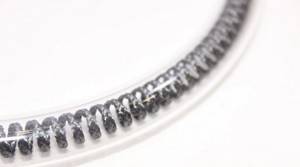
Carbon spiral
After purchasing and installing it on a special tripod, the emitter is adjusted to the desired height and secured. After which you can connect it to a network with a rated voltage of up to 230 volts. Due to high thermal conductivity, the speed at which the spiral reaches maximum temperatures exceeds that of metals. The use of a quartz housing for the heating element is required in order to transmit heat at minimal cost when passing through the material. It is these parameters that allow the heater to be used most effectively in many situations.
Warming up of the room occurs due to the heating of the surfaces of objects that are exposed to radiation from the refractor. After which the heat is transferred to the environment through the air. In this case, no heat consumption is observed when passing through oxygen, since the long wave of infrared radiation from carbon can be absorbed exclusively by dense media. Due to the depth of heating, even after the refractor is turned off, outgoing heat is observed for a long time.
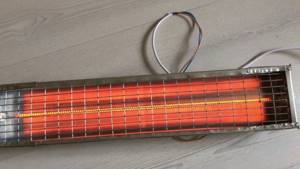
Hot heating element
Some units can be additionally equipped with sensors to measure the temperatures of the heated area. Thus, the system will automatically try to maintain a stable level in the room. Additionally, the unit is equipped with an automatic shutdown system when there is a sudden change in position in space, or when tilt angles are reached that cannot guarantee safe operation
Basic operating instructions and safety precautions
To prevent accidents such as burns and electrical shock, the following manufacturer recommendations must be followed:
- Do not place flammable objects such as tablecloths, table lamps and floor lamps with lampshades, curtains and other textile decorative elements in close proximity to the device;
- It is prohibited to dry things and clothes on the surface of the carbon heater;
- Electrical cables should not be placed under carpets, in areas of high humidity, or under moving doors and furniture;
- Do not leave the heater unattended while it is on;
- Only qualified specialists can be involved in repairs.
The operation of carbon devices is no different from other mobile heaters - you need to find a safe place and plug it into the network. Variations for wall and ceiling installation are equipped with brackets and pre-assembled fasteners.
To prevent accidents associated with electrical injuries and burns, as well as to ensure the heater service life declared by the manufacturer, the following safety rules must be followed:
- It is prohibited to place heaters in close proximity to flammable objects (curtains, tablecloths, floor and table lamp shades, etc.).
- Drying items on electric heaters is not allowed.
- It is prohibited to place electrical cables under carpets, moving door leaves, or in areas of high humidity or water in the open.
- It is also prohibited to leave heaters on unattended.
- Repairs to carbon heaters should only be carried out by qualified specialists.
Following these rules will protect users not only from accidents, but also from disappointment in these modern, functional home heaters.
Interesting Facts
One of the most interesting features of heaters of this type is the ability to have a beneficial effect on the health of the human body. The infrared radiation that comes from the device penetrates quite deeply into the body. This, in turn, significantly improves blood circulation in the tissues. In practice, we are talking about thermal physiology, which is carried out right in your home.
As for official medicine, it fully approves of the use of carbon infrared heaters in the treatment of certain diseases. These include the prevention of the following pathologies:
- inflammatory processes in muscles and joints,
- pain in legs, back,
- colds,
- arthritis and others.
So such a heater can be used to warm up a child in case of a cold.

Radiation from a carbon fiber heater has a beneficial effect on the health of the human body
Today, carbon heaters are an almost ideal device for creating and maintaining a certain indoor microclimate. This is an environmentally friendly, safe, economical and durable device, which in some cases is equipped with a swivel stand, and is also necessarily equipped with a protection system against various unforeseen situations.
Basically, such devices are controlled using rotary controls located on the body of the device. But more advanced models have remote controls at their disposal, allowing you to set the temperature regime in which the device will operate without even getting up from the couch.
The principle of operation of the device, the effect on the body and features of use
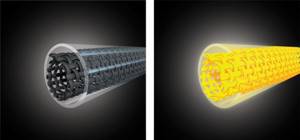
A carbon heater (reviews about it are mostly positive) is a special type of infrared device with a very simple operating principle. The fact is that the device does not increase the air temperature in the room. It heats things up. It is from them that heat is transferred to the air. That is, such heaters have a targeted effect.
It should be noted that the product is quite effective: it heats objects approximately 2 cm deep. Even if you are in a room with a negative temperature, such a device can provide your body with warmth in a few minutes. Conventional heaters cannot do this.
Since infrared waves are long, they do not burn oxygen. Therefore, even in those rooms where normal air circulation is impaired, the heater will be very useful.
Users often look for information on the topic “Carbon heater: harm or benefit?” It must be said right away that the infrared radiation provided by the presented device is not capable of causing any cancer or other diseases. On the contrary, such a heater can be beneficial.
Thanks to the deep penetration of waves, the device can activate blood circulation and improve metabolism. This “gentle warmth” has a beneficial effect on the joints, which helps get rid of arthritis and other similar pathologies. You can even use the device to prevent colds, muscle inflammation, and leg pain.
As for its use, everything is simple. You just need to plug the device into a power outlet and set the required power. It is controlled using regulators on the body. Some models are equipped with a remote control module.
